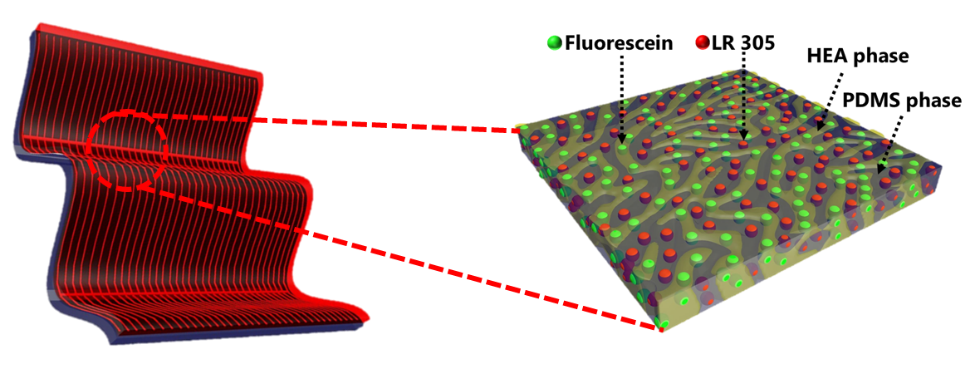Amphiphilic Polymer Conetworks – Wearable and High Energy Transfer Rate Luminescent Solar Concentrators
Luminescent solar concentrators (LSCs) have attracted considerable attention in recent years for their advantages in absorbing diffusive light and increasing the cost-effectiveness of solar cells; however, the compatibility with flexible photovoltaics and the energy transfer (ET) efficiency still require improvement. In our current work [1], amphiphilic polymer conetworks (APCNs) are employed as polymer matrices for wearable LSCs owing to their flexibility and wearability. Furthermore, with the assistance of APCNs’ nanophase separated hydrophobic and hydrophilic domains, hydrophobic (Lumogen Red, acceptor) and hydrophilic (fluorescein, donor) luminescent materials are loaded in adjacent nanometer-separated domains. This results in high ET rates and broaden the acceptor’s absorption range, rendering a more efficient down conversion emission. With this straightforward synthesis procedure, we could achieve high ET rates between dye pairs via FRET and photon recycling. This two energy transfer mechanisms were confirmed by steady-state and dynamic photoluminescence methods, showing a ~100% total ET between donors and acceptors.
Applying the loaded APCN as a coating, we were able to increase the efficiency of flat solar cells by matching its absorption profile with the emission range of the dye pairs (e.g. pc-Si PVs PCE increased of 14.5% in the excitation range of 375-550 nm). The developed nanostructure-assisted ET system is not limited to the dyes investigated here, but can be directly extended to a wide variety of dyes (Rhodamine B, HPTS, DCM, and Lumogen Yellow) and quantum dots (CsPbBr3 and CdSe/ZnS). Furthermore, the re-emitted photons are monitored via geometry photoluminescence measurement and Monte Carlo ray tracing simulation, indicating the APCNs LSC vertically-tandem attached to the flexible photovoltaics can effectively increase the light absorbing area and be beneficial to the optimal utilization of incident light. This novel APCN could find potential uses in the energy-harvesting field, serving as wearable LSCs for the next generation of flexible and wearable photovoltaics.

Figure 1. Scheme of flexible tandem LSC/PVs with APCN containing two dyes forming FRET pairs
[1] C.-S. Huang, K. Jakubowski, S. Ulrich, S. Yakunin, M. Clerc, C. Toncelli, R. M. Rossi, M. V. Kovalenko, and L. F. Boesel, Nano Energy, 2020, 76, 105039